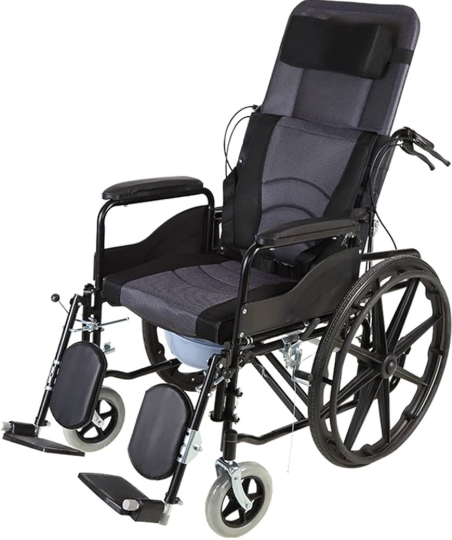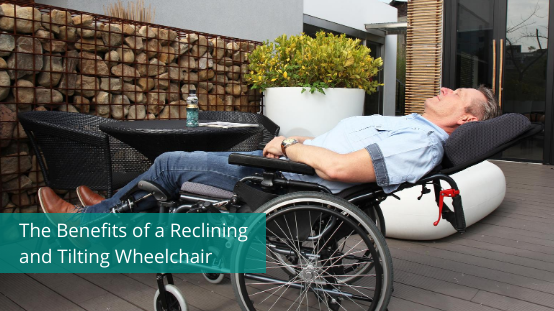The Purpose Of A Reclining Wheelchair
What is the purpose of a reclining wheelchair? Ever wonder why some wheelchairs tilt and recline? These features do more than provide comfort—they help with health and well-being for people who sit for many hours. Reclining chairs ease pressure points, boost blood flow, and fix posture. I’ve found that most people miss a key point when picking or using these chairs. What’s that point? The right angle matters!
Pressure Relief
Reclining wheelchairs with tilt-in-space features help spread pressure and prevent pressure ulcer for people who sit for long periods.
Finding Relief: My Journey with Wheelchair Positioning
When I use a 25° tilt with a 120° recline, I feel instant relief across my body. The pressure fades away. Blood flows to areas that were once squeezed and painful.
I’ve found that a 35° tilt with a 120° recline works best for me. This mix feels like being held in a safe space. It boosts blood flow and protects my sensitive tissues.
My research shows sitting pressure drops by up to 78% when I use angles between 35° tilt and 65° recline. It feels like taking off a heavy load – the relief comes right away.
Reclining past 90° cuts pressure, but I notice it can cause skin drag without proper tilt. I’ve learned that mixing these positions is an art. When done right, it creates real comfort.
I suggest holding a 35° tilt with 120° recline for at least 3 minutes. These 180 seconds give my body a break. Short breaks don’t give my tissues enough time to recover.
Power tilt and recline chairs have changed lives for people with spinal cord injuries who can’t move on their own. These chairs protect skin, posture, and health like a full-time helper.
Pressure ulcers cost the United States over $1.35 billion each year. I believe good positioning systems save money through prevention while giving comfort and respect that can’t be measured in dollars.
Reclining wheelchairs support both health and save money, making them vital prevention tools.
Improved Comfort and Posture
Reclining wheelchairs offer better comfort and good posture with their adjustable parts that meet many health and physical needs. Here are the main benefits:
Enhanced Seating Position and Back Support
You can change the back angle for a comfy sitting position. This cuts down on muscle and joint strain.
Soft armrests, leg supports, and head rests give custom support for people with health needs or disabilities.
Improved Posture and Alignment
The recline helps keep the spine straight. I find this helps people with cerebral palsy and spinal injuries.
Reclining makes posture better for those with muscle or bone problems.
Extended Comfort and Health Benefits
These chairs are built for comfort during long sitting times.
Changing positions helps users breathe better and improves blood flow.
Notable Features and Examples
High Back Reclining Wheelchairs:
Prices start at $270.44 (Grace Medy) and go up to $3,195 based on features like hydraulic recline and comfort upgrades.
Reclining Angles:
Chairs recline from 90° to 180°. Better models have extra head support and leg rest options.
Special Designs for Medical Applications:
Features include light frames made of aluminum or steel, systems to prevent sliding, and strong cushions for comfort.
Use in Care Environments:
Common in nursing homes, hospitals, and rehab centers to help with posture and lower risks of bed sores or back pain.
Assistance with Blood Circulation
Reclining wheelchairs help improve blood flow by taking pressure off veins and helping blood return to the heart. This helps stop blood from pooling, reduces swelling, and eases leg discomfort. Here are the main ways these chairs help with blood flow:
Benefits of Tilt and Recline Angles
Bigger tilt and recline angles boost circulation:
A 45° tilt with a 15° recline increases blood flow.
Other angles like 35° tilt with 30° recline also improve blood flow.
Raising the legs above heart level uses gravity to help blood return, cut down fluid buildup, and lower the risk of vein problems.
Better Circulation Support
Reclining helps support blood flow to areas that need oxygen. This cuts down the risk of pressure sores.
I recommend keeping reclined positions for at least 3 minutes to boost steady blood flow.
Special Features for Blood Flow
Chairs with elevating leg rests and tilting parts give extra support for people with poor vein function or after surgery.
Top models, like “zero gravity” recliners, spread weight across the body. This lowers stress on blood vessels and improves overall flow.
Facts and Examples
Research shows positions like 45° tilt with 30° recline or 15° tilt with 30° recline boost circulation and reduce swelling.
Features like leg elevation also improve blood flow and reduce tiredness.
By spreading pressure and supporting good circulation, reclining wheelchairs improve vein health and give relief to users who need better blood flow.
How Reclining Wheelchairs Help Caregivers
Reclining wheelchairs offer many features that make caregiving tasks easier, improve care, and boost efficiency. Here’s how these wheelchairs support caregivers:
| Feature | Details |
|---|---|
| Easy Position Changes |
These wheelchairs can recline to an almost flat position – up to 180 degrees in some models. This makes moving users to beds or cleaning them much easier. Many chairs have simple hydraulic systems and easy-to-use controls for quick adjustments. |
| Pressure Relief for Long Sitting |
Reclining helps spread weight across the user’s body, cutting down the risk of sores and skin problems. This means fewer care steps needed, giving caregivers time for other important tasks. |
| Better Access for Medical Care |
Adjustable positions give better access to different body areas. This makes wound care and catheter management less tiring and faster. |
| Safer Transfers |
Movable armrests and reclining features make moving patients safer and simpler. Safety elements like anti-tip devices and wheel locks boost confidence during transfers. |
| Adjustable to Match Each Person |
These chairs often have adjustable seat heights, leg supports, and headrests to fit different users. This cuts the need for extra equipment, making caregiving more straightforward. The Ranger SpacePro XXL, for example, offers many settings to help caregivers work better. |
| Tilt Features |
Some chairs can tilt the whole seat without changing the user’s sitting position. This means fewer adjustments throughout the day, saving time while keeping users comfortable. |
| Less Strain on Caregivers |
Models with lightweight frames made of titanium or carbon fiber for easier pushing are recommended. Good handles and smooth mechanics reduce the effort needed for care tasks. |
These reclining wheelchairs provide comfort for users while helping caregivers deliver better care with less strain. They make care routines safer and easier.
Prevention of Postural Hypotension
Reclining wheelchairs help manage postural hypotension (also called orthostatic hypotension). This condition causes blood pressure to drop when changing positions, leading to dizziness or fainting.
Mechanism of Relief
These wheelchairs let users make careful body position changes.
Changing the backrest angle and raising the legs helps blood flow. This cuts down on heart strain and stops blood from pooling in the legs.
Patient Needs
I find these chairs work well for people with bad orthostatic hypotension, like those with spinal cord injuries.
The chairs’ adjustable positions can keep blood pressure steady and stop fainting. Settings can match each person’s heart needs.
Added Features
Special parts like sliding backrests cut down on friction when changing positions.
These parts keep users safe by protecting skin and making position changes smoother.
Daily Use
Moving positions often in these wheelchairs helps:
Control blood pressure drops.
Fight tiredness.
Keep users more comfortable with steady blood pressure.
Extra Support Options
Power recline systems and leg lifts make the chairs work even better.
Putting legs above heart level helps blood flow back to the heart.
My Advice
I suggest users think about their specific needs when picking a wheelchair, including how severe their condition is.
Safety belts and special friction-reducing features are key for safety and making the chair work its best.



